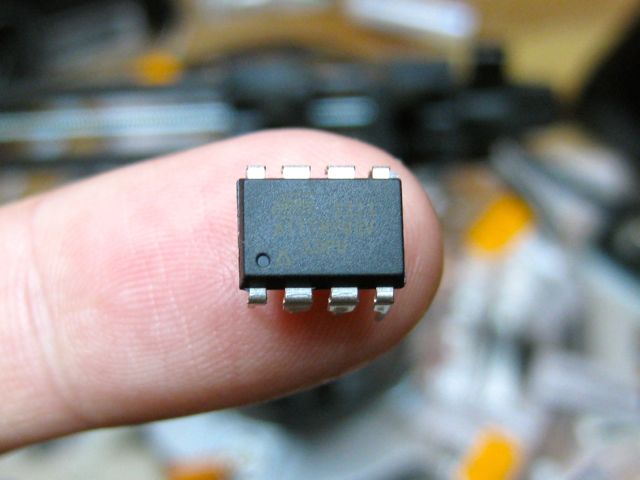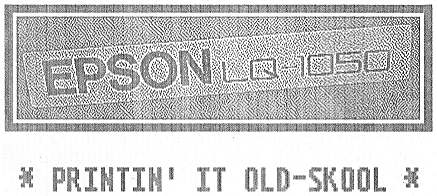Author: scruss
-
last past th’ epost
I’ve had a full billing cycle go through epost now, and would like to note that:
- EFT direct payment — the kind I had to send through a void cheque — isn’t actually supported by any of the companies I use. It might be my bank being useless, but it’s a waste of time for me. I still have to faff with online banking for payments.
- The “Record a Payment” feature appears to be designed for inline PDF viewing. It took me ages to find it on the bill page, since my PDF bills appear in Preview.
My second favourite utility, Bell Canada (the first being all the others), seems to want me to use their online One Bill service rather than epost. Bell Canada posts their bills on their internal system first, then on epost a few days later.
-
2011 Award for worst-directed charity mail …
… goes to the Canadian War Museum. I’m just an average white poppy wearing guy, so I replied thus:
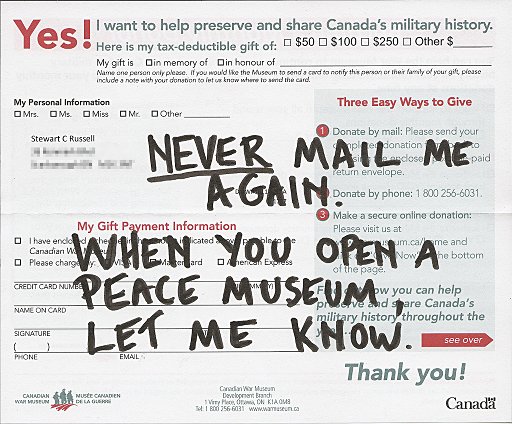
-
I ♥ 10m
And this is why I do ham radio:
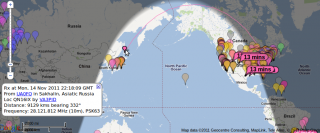 Worked a pileup on UA0FO, Sergey on Sakhalin. Yeah, those islands just north of Japan … y’know, the whole part of the world my antenna doesn’t even point near.
Worked a pileup on UA0FO, Sergey on Sakhalin. Yeah, those islands just north of Japan … y’know, the whole part of the world my antenna doesn’t even point near.(picture from Philip Gladstone’s entirely awesome PSKReporter)
-
Yours truly, ‰te>a…t
I like epost. I’d like it even more if they hurried up and processed my direct payment ability — which required a form and a void cheque mailed to an address in Toronto — but it’s a pretty good service. I get my bills, viewable and payable online, on the day of issue. No paper. This is good.
This is good because every single filing container I buy eventually ends up full of (paid) bills and financial administrivia. Less paper = less messy Stewart = happy Stewart. Some messes, like my electronics table, could be classed as glorious, however, and therefore joyous in their creation and use. Not all tidiness is good.
So I got my first Visa bill by e-post. Yay! Reviewed it, paid it. No hassle. But since this a PDF facsimile of my bill, something mighty odd has happened to my address:
 It’s a perfect substitution cypher of my name and address. I’ve been out of the prepress industry for long enough not to immediately recognize it as a font encoding error. I’m confused why it might have A, T, E & N, but no M. Odd indeed.
It’s a perfect substitution cypher of my name and address. I’ve been out of the prepress industry for long enough not to immediately recognize it as a font encoding error. I’m confused why it might have A, T, E & N, but no M. Odd indeed. -
Chirp, the universal HT programmer
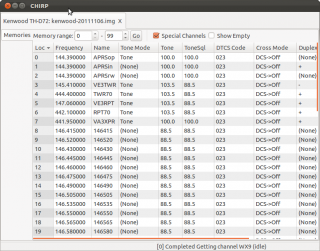 CHIRP is rather good. It replaces all the horrid proprietary HT programming software with one cross-platform, cross-radio solution. It allowed me to program my new Kenwood from data from my Wouxun. It uses transparent file formats, and can import from everything. It’s great!
CHIRP is rather good. It replaces all the horrid proprietary HT programming software with one cross-platform, cross-radio solution. It allowed me to program my new Kenwood from data from my Wouxun. It uses transparent file formats, and can import from everything. It’s great!Update: Whoa! It can now program my FT-857D! I just uploaded all the repeaters within 50km, and there’s a bunch going on on a few of them.
-
It’s Ill-Advised Facial Hair Month!
It begins with a shave …
 Yes, I’ve signed up for Movember. Sponsor me, or I’ll grow a Holiday Neckbeard …
Yes, I’ve signed up for Movember. Sponsor me, or I’ll grow a Holiday Neckbeard … -
last of the daisy-ish things
 Cleared out a ton of these from the front garden. They smell good when you pick ’em.
Cleared out a ton of these from the front garden. They smell good when you pick ’em.(Taken with Catherine‘s nifty new camera.)
-
Legions of young Canadian photographers say …
 “Hey Henry’s, that’s not how you spell ‘environment’!”
“Hey Henry’s, that’s not how you spell ‘environment’!” -
24 pins to the platen
Thanks to Seneca, I now have this noisy, slow behemoth in my basement.
It’s kind of neat that Ubuntu supports this 24 year old printer out of the box.
-
24 hours after sending 286 digital QSL cards …
Of the 286 secure digital QSL cards I sent, 8 were undeliverable. I’ve had 25 responses so far:
- Fourteen positive
- Three wondering if I hadn’t seen their confirmation on eQSL/QRZ/LoTW
- Two that don’t accept QSLs of any kind
- One language issue; I have “Report” when “RST/RSQ” might be clearer internationally
- One completely neutral
- One auto responder
- One with no record of a QSO in their log
- One saying their callsign has been hijacked and that they are no longer an active ham
- One negative
Of the positive ones:
- Two have also sent real QSL cards (thanks, guys, but really, you shouldn’t have …)
- Two asked how I did it.
Pretty good and quick response, I thought.
-
(Not Just) Firefox’s “Pile of Poo” Easter Egg: 💩
For a reason best known to the Unicode consortium, there is now the symbol U+1F4A9 “Pile of Poo”: 💩. If you happen to create a web page with this delightful character in the title, Firefox does something special:
 Yep, that’s a smiley face poo, a bit like Mr Hankey. Oh dear.
Yep, that’s a smiley face poo, a bit like Mr Hankey. Oh dear.Actually, it seems it might be an OS X Emoji thing, because Safari renders it in the title like that, and in the text as (enlarged
to show texture): iOS has it covered too:
iOS has it covered too: Blackberry’s browser just shows a small black square. Android, rather sensibly, shows an empty square. It must be an Apple thing.
Blackberry’s browser just shows a small black square. Android, rather sensibly, shows an empty square. It must be an Apple thing.“Thanks†go to tchrist‘s comment in unicode – Why does modern Perl avoid UTF-8 by default? for alerting me to this character, and letting us know about the Symbola font that supports it. Yeah, cheers Tom …
-
Secure digital QSL cards, part 2: shell script
Following on from Creating secure digital QSL cards with your LoTW certificate, here’s a Bash script to generate encrypted signed PDF QSLs. You will need to edit the certificate file name, the QSL blank file name, your call sign, your LoTW password and the PDF encryption password. After doing so, please keep the script safe, as whoever has your LoTW password can pretend to be you.
The only checks that this script doesn’t do (and probably should) are if you have pdftk and PortableSigner executables in your path. PortableSigner is rather weird the way it runs; you need to specify full paths for all files, or it dies.
The script is called like this:
mkdqsl.sh callsign date utc mhz mode report
for example:
mkdqsl.sh VE3KPK 2011-10-02 2341 7.03581 CW 499
Code below the fold.
-
Good old PCD0992 …
 I found the good old Kodak Photo CD sample images on the site linked through from the photo. Test images for MFSK image radio transmission, here we come!
I found the good old Kodak Photo CD sample images on the site linked through from the photo. Test images for MFSK image radio transmission, here we come!I got this CD with OS/2 Warp back in early 1995. My machine didn’t like Warp at all; it repeatedly fork-bombed in the file manager, so it was essentially a £40 paperweight. So burned was I with commercial software that I bought a Slackware distro so I could run something more fun that Windows 3.11. I’ve been happily running Linux since then.
-
No work of art …
 but it is my first working lead-free, SMT soldered circuit. I have two SoftRock Ensemble RXTX radios to build, and I thought it would be better to melt a $10 trainer kit than a $100 radio. It works as expected, though I wouldn’t describe the red/green LED’s insane flickering to be “an attractive and functional SMD dual color LED flasherâ€.
but it is my first working lead-free, SMT soldered circuit. I have two SoftRock Ensemble RXTX radios to build, and I thought it would be better to melt a $10 trainer kit than a $100 radio. It works as expected, though I wouldn’t describe the red/green LED’s insane flickering to be “an attractive and functional SMD dual color LED flasherâ€.Flux is your friend here. I tried Chaney’s recommended method of supergluing components on the board, but that didn’t work. What ended up best was applying flux to all the pads, supplying the thinnest layer of solder possible, refluxing the pads, then flowing on the components. A steady hand, a magnifier, tiny (½mm) solder, good tweezers and a pointy soldering iron helps. Some kind of fume extraction is good, too, as Pb-free flux is a tad acrid.
I don’t miss eutectic leaded solder. Sure, it’s easy to use, and it’s got a kind of magical quality that it’s below the melting point of either lead or tin. But Sn-Ag solder is toxic enough, and I don’t need to dump more lead in the world.
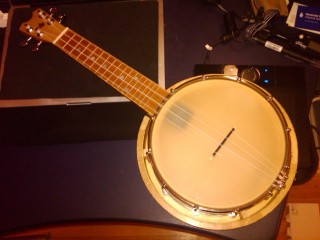

 XLD
XLD
